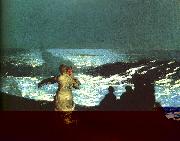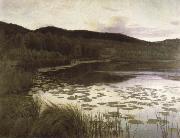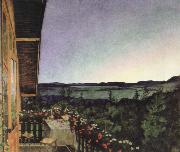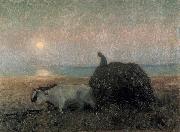Wholesale Oil Painting No Minimum |
|||||||||||
|
|
|||||||||||

|
|||||||||||
|
|
|
||||||||
Winslow Homer1836-1910 Winslow Homer Locations Winslow Homer (February 24, 1836 ?C September 29, 1910) was an American landscape painter and printmaker, best known for his marine subjects. He is considered one of the foremost painters in 19th century America and a preeminent figure in American art. Largely self-taught, Homer began his career working as a commercial illustrator. He subsequently took up oil painting and produced major studio works characterized by the weight and density he exploited from the medium. He also worked extensively in watercolor, creating a fluid and prolific oeuvre, primarily chronicling his working vacations. |
||||||||
|
|
||||||||
Summer Night
Summer Night Painting ID:: 4161 |
1890
Musee d'Orsay, Paris 1890 Musee d'Orsay, Paris |
|||||||
|
|
||||||||
Piet MondrianDutch 1872-1944 Piet Mondrian Location was a Dutch painter. He was an important contributor to the De Stijl art movement and group, which was founded by Theo van Doesburg. He evolved a non-representational form which he termed Neo-Plasticism. This consisted of a grid of vertical and horizontal black lines and the use of the three primary colours. When 47-year-old Piet Mondrian left his artistically conservative native Holland for unfettered Paris for the second and last time in 1919, he set about at once to make his studio a nurturing environment for paintings he had in mind that would increasingly express the principles of Neo-Plasticism about which he had been writing for two years. To hide the studio's structural flaws quickly and inexpensively, he tacked up large rectangular placards, each in a single color or neutral hue. Smaller colored paper squares and rectangles, composed together, accented the walls. Then came an intense period of painting. Then again he addressed the walls, repositioning the colored cutouts, adding to their number, altering the dynamics of color and space, producing new tensions and equilibrium. Before long, he had established a creative schedule in which a period of painting took turns with a period of experimentally regrouping the smaller papers on the walls, a process that directly fed the next period of painting. It was a pattern he followed for the rest of his life, through wartime moves from Paris to London??s Hampstead in 1938 and 1940, across the Atlantic to Manhattan. At 71 in the fall of 1943, Mondrian moved into his second and final New York studio at 15 East 59th Street, and set about again to create the environment he had learned over the years was most congenial to his modest way of life and most stimulating to his art. He painted the high walls the same off-white he used on his easel and on the seats, tables and storage cases he designed and fashioned meticulously from discarded orange and apple-crates. He glossed the top of a white metal stool in the same brilliant primary red he applied to the cardboard sheath he made for the radio-phonograph that spilled forth his beloved jazz from well-traveled records, Visitors to this last studio seldom saw more than one or two new canvases, but found, often to their astonishment, that eight large compositions of colored bits of paper he had tacked and re-tacked to the walls in ever-changing relationships constituted together an environment that, paradoxically and simultaneously, was both kinetic and serene, stimulating and restful. It was the best space, Mondrian said, that he had ever inhabited. Tragically, he was there for only a few months: he died of pneumonia in February 1944. |
||||||||
|
|
||||||||
|
|
Summer night
Summer night Painting ID:: 53076 |
mk226
71x110.5cm
1906-1907
mk226 71x110.5cm 1906-1907 |
||||||
|
|
||||||||
Kitty KiellandNorwegian Painter, 1843-1914 was a Norwegian landscape painter. Kielland was born to an affluent family in Stavanger, the older sister of Alexander Kielland. Kielland's mutual interactions with her brother would be important to shaping her as an artist. Although she received some training in drawing and painting, it was not until she turned thirty that she was allowed to train as a professional artist. In 1873 she traveled to Karlsruhe where she was trained by Hans Gude. As a woman Kielland was forced to take private lessons from Gude instead of joining his landscape painting class. Gude's adherence to realism left a lasting impression on Kielland that was visible in her later works.[ |
||||||||
|
|
||||||||
|
|
summer night
summer night Painting ID:: 56318 |
mk247
1886,oil on canvas,39x53 in,100.5x135 cm,national gallery,oslo,norway mk247 1886,oil on canvas,39x53 in,100.5x135 cm,national gallery,oslo,norway |
||||||
|
|
||||||||
Harald SohlbergHarald Oskar Sohlberg (29 September 1869?C19 June 1935) was a Norwegian Neo-romantic painter, particularly known for his depictions of the mountains of Rondane and the town of Røros. His perhaps most well-recognized painting is his 'Fisherman's Cottage' from 1907. |
||||||||
|
|
||||||||
|
|
summer night
summer night Painting ID:: 56369 |
mk247
1899,oil on canvas,45x53.5 in,114x136 cm,nasjonalgalleriet,oslo,norway mk247 1899,oil on canvas,45x53.5 in,114x136 cm,nasjonalgalleriet,oslo,norway |
||||||
|
|
||||||||
Maurice Galbraith CullenMaurice Galbraith Cullen (1866-1934) was a Canadian artist. Cullen was born June 6, 1866 in St. John's, Newfoundland. Beginning in January 1918, Cullen served with Canadian forces in the First World War. He came to the attention of Lord Beaverbrook, who arranged for him to be commissioned as an "official war artist" along with Frederick Varley, J.W. Beatty and C. W. Simpson. |
||||||||
|
|
||||||||
|
|
Summer Night
Summer Night Painting ID:: 90475 |
1907(1907)
Medium oil on canvas
Dimensions 76.1 x 101.2 cm (30 x 39.8 in)
cyf 1907(1907) Medium oil on canvas Dimensions 76.1 x 101.2 cm (30 x 39.8 in) cyf |
||||||
|
|
||||||||
|
Maurice Galbraith Cullen Maurice Galbraith Cullen (1866-1934) was a Canadian artist. Cullen was born June 6, 1866 in St. John's, Newfoundland. Beginning in January 1918, Cullen served with Canadian forces in the First World War. He came to the attention of Lord Beaverbrook, who arranged for him to be commissioned as an "official war artist" along with Frederick Varley, J.W. Beatty and C. W. Simpson. Summer Night 1907(1907) Medium oil on canvas Dimensions 76.1 x 101.2 cm (30 x 39.8 in) cyf |
||||||||
|
|
||||||||
|
Prev Next
|
||||||||
|
|
||||||||
|
Related Paintings to Maurice Galbraith Cullen :. |
||||||||
|
|
||||||||
|
CONTACT US |





